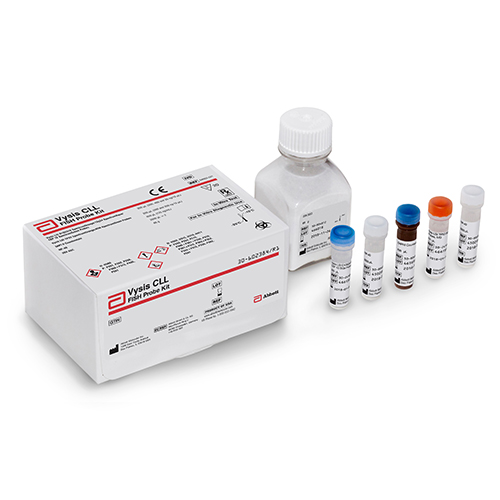The Vysis CLL FISH Probe Kit uses FISH DNA probe technology to determine deletion status of probe targets for locus-specific identifier (LSI) TP53 (containing tumor protein p53 gene, located on chromosome 17p), LSI ATM (containing ataxia telangiectasia mutated gene, located on chromosome 11q), and LSI D13S319 (containing marker D13S319, located on chromosome 13q), as well as determining trisomy 12 with CEP12 (D12Z3 alpha satellite, located on chromosome 12). The Vysis CLL FISH Probe Kit includes LSI 13q34 (containing lysosomal-associated membrane protein 1 gene, located on chromosome 13q) as a control probe.
Explanation of the Test
Chronic lymphocytic leukemia (CLL) is the most common form of adult leukemia in the developed world. Approximately 1 in 202 men and women will be diagnosed with CLL during their lifetime. The median age at diagnosis is approximately 70 years of age. Incidence rates are higher for males (6.44 per 100,000 population) than females (3.51 per 100,000 population). Leukemia incidence is highest among non-Hispanic whites (13.6 per 100,000 population); incidence is lowest among Asian and Pacific Islander populations (7.4 per 100,000 population) and American Indian and Alaska Native populations (7.3 per 100,000 population).
Probe Targets Information
The tumor suppressor protein, p53, has been shown to play a critical role in oncogenesis and response to chemotherapy in a variety of human cancers. In humans, the TP53 gene is found on the short arm of chromosome 17 (17p13) and is reported to be suppressed or mutated in a large number of human cancers. Deletions of the 17p region resulting in abnormalities of the tumor suppressor protein p53 have been identified as one of the poorest prognostic factors for CLL as it is predictive of short time to disease progression, short response duration, lack of response to therapy and short overall survival (OS).
The 17p deletion is more frequently observed in treated patients than in previously untreated patients, increasing in frequency during the course of the disease with up to 50% of patients with relapsed or refractory disease having the deletion. Approximately 8 to 12% of patients with CLL in the first line treatment carry del 17p.6 It is widely accepted that treatment outcomes in patients with del 17p are poor.
Once patients fail purine analog based chemoimmunotherapy, subsequent therapies provide shorter progression-free survival (PFS). 8 The outcome to treatment is strongly impacted by several molecular biologic features and several nonrandom cytogenetic alterations and oncogenes. In particular, an ultra-high risk group of CLL patients has been defined who have deletion of the short arm of chromosome 17 (del17p) with a median life expectancy of less than 2 to 3 years.
Patient Impact
Currently, most patients diagnosed with CLL have early stage-disease (Rai stage 0 or 1). Patients with early-stage CLL are a heterogeneous group; approximately 30% to 50% are at high risk of accelerated disease progression, and the remainder may live for decades and possibly never require therapy. Recent insights into the biological characteristics of leukemic B cells have led to the discovery of new prognostic tools (immunoglobulin variable-region heavy chain gene mutation status, cytogenetic abnormalities assessed by fluorescence in situ hybridization [FISH], and Z-chain-associated protein kinase-70 protein expression) that can contribute to the identification of patients with early-stage disease who are at high risk for early disease progression.
Routine karyotype analysis only detects chromosomal aberrations associated with CLL in 40% to 50% of the cases. Use of FISH and other technologies have detected genomic abnormalities in over 80% of cases of CLL. The common genomic aberrations seen are trisomy 12 and deletions of 13q, 17p, and 11q.
Several published studies suggest that some of these chromosomal abnormalities may be correlated with various disease parameters.
Intended Use
The Vysis CLL FISH Probe Kit is intended to detect deletion of the LSI TP53, LSI ATM, and LSI D13S319 probe targets and gain of the D12Z3 sequence in peripheral blood specimens from patients with B-cell chronic lymphocytic leukemia (CLL). The assay may be used to dichotomize CLL (the 13q-, +12, or normal genotype group versus the 11q- or 17p- group) and may be used as an aid in determining disease prognosis in combination with additional biomarkers, morphology, and other clinical information.
The test is for prescription use only.
Indications and Limitations Of Use
Limitations of the Procedure
For in vitro diagnostic use only.
- The Vysis CLL FISH Probe Kit is intended to be used in combination with additional biomarkers, morphology, and other clinical information.
- Other signal patterns may occur, and metaphase analysis may be helpful in characterization of such patterns.
- If a specimen has a low level abnormal FISH pattern, use of the appropriate single pass filter(s) to confirm the pattern is recommended. Failure to follow this recommendation may result in inaccurate identification of signal patterns.


